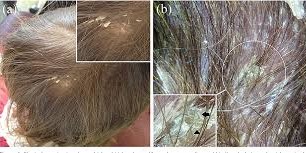
It is an eczematous condition in which there is
excessive scaling of the scalp. Thick silver –yellow scales are firmly adherent
to associated hair and the scalp. The scales bind down the tufts of hair.
Considered to be inflammatory skin conditions like psoriasis, seborrhoeic
dermatitis, tinea capitis. The scales look like asbestos hence it is also known
as Tinea Amiantacea.
CAUSES:
1. Psoriasis
2. Well-defined red scaly plaques on elbows and
knees (chronic plaque psoriasis)
3. Red shiny patches in skin folds (flexural
psoriasis)
4. Seborrhoeic dermatitis
5. Patches similar to psoriasis but less
well-defined and less red on the scalp and scale tends to be yellowish
6. Tinea capitis
7. Fungal culture might reveal dermatophyte
fungus on the scalp.
8. Localized scaly bald patches on the scalp may
result in broken or loose hairs.
9. Head lice
10. Egg cases present on the hair shaft and
scurrying lice found on the back of the neck and behind ears
11. Possibility of cervical lymph node enlargement
12. Lichen simplex
13. Localized itchy dry patch of skin
14. Often at the back of scalp
15. Thickened, darkened plaques with broken-off
hairs due to scratching excessively.
DIAGNOSIS:
1. Since Pityriasis amiantacea symptoms have a
close resemblance with other conditions such as psoriasis, seborrhoeic dermatitis
or lichen planus.
2. Easily may be misdiagnosed, however, scales,
in this case, can be distinguished as they are attached to both hair shaft
and the scalp.
3. Skin and hair samples may be used for mycology
and scalp biopsy is rarely conducted but depends on an individual case.
TREATMENT:
1. In most cases, topical keratolytic treatment
with topical corticosteroids may be suggested as a primary treatment
option.
2. Anti-inflammatory topical solution or mineral
oil helps detach the adherent scales.
3. Antibiotics are an option if the underlying cause is found to be due to Staphylococcus aureus.
4. Peeling of scabs has to be strictly avoided as
it may cause further infection leading to Scarring Alopecia.
5. Anti-fungal treatment is an option in cases in
which fungal infection has been suspected.
6. At Royal Hairnic we are assessing the causes
diligently as Pityriasis amiantacea can share symptoms of other conditions
making diagnosis an important and integral part before proceeding with the
treatment.
For any additional information or to book an
appointment, kindly contact us on
